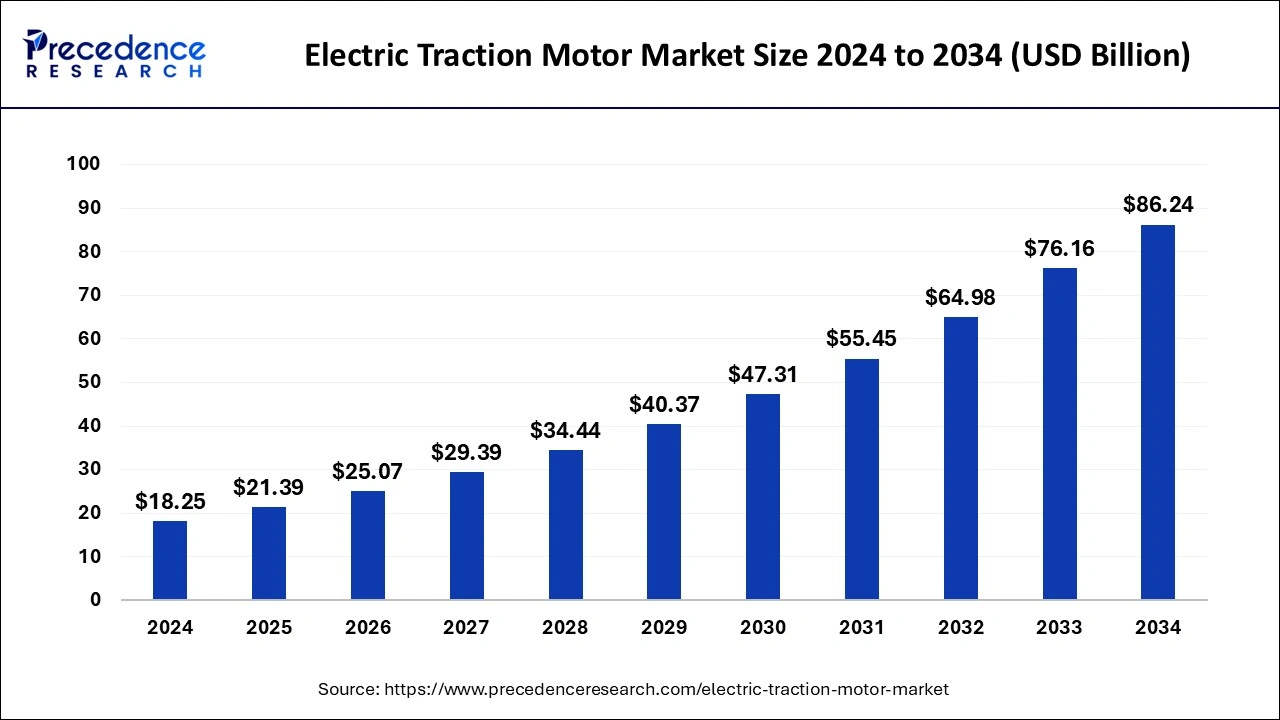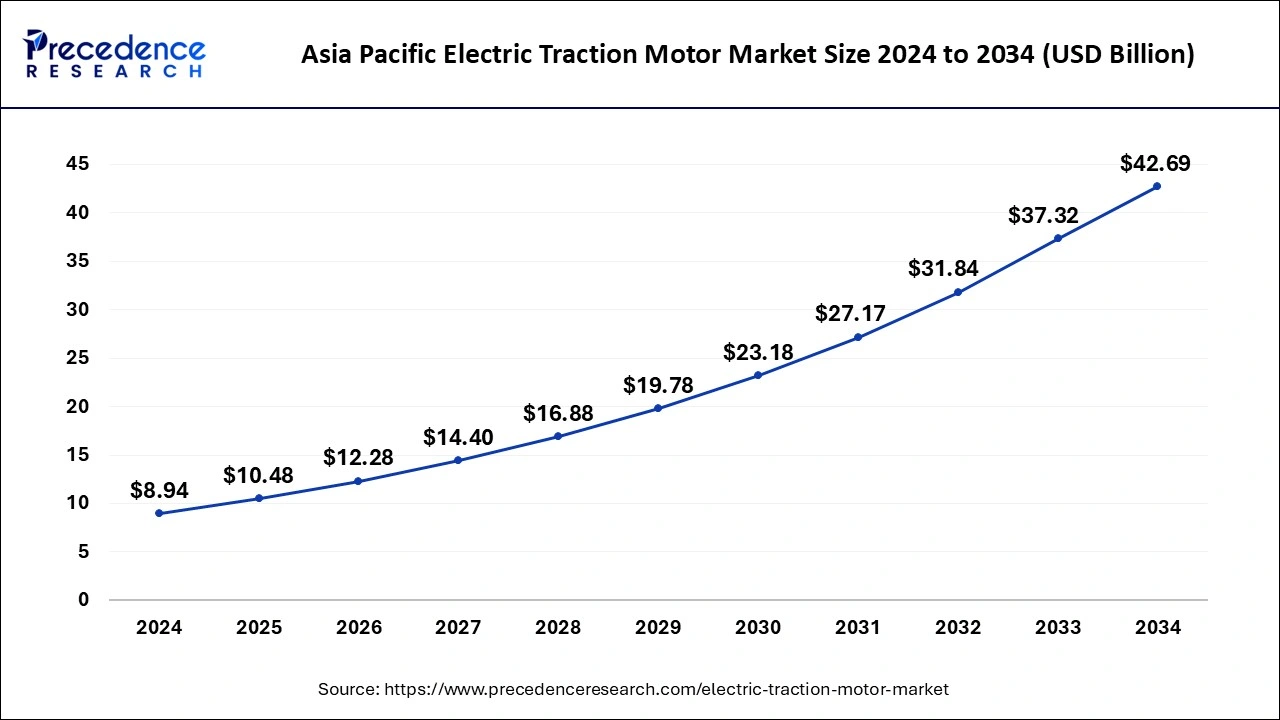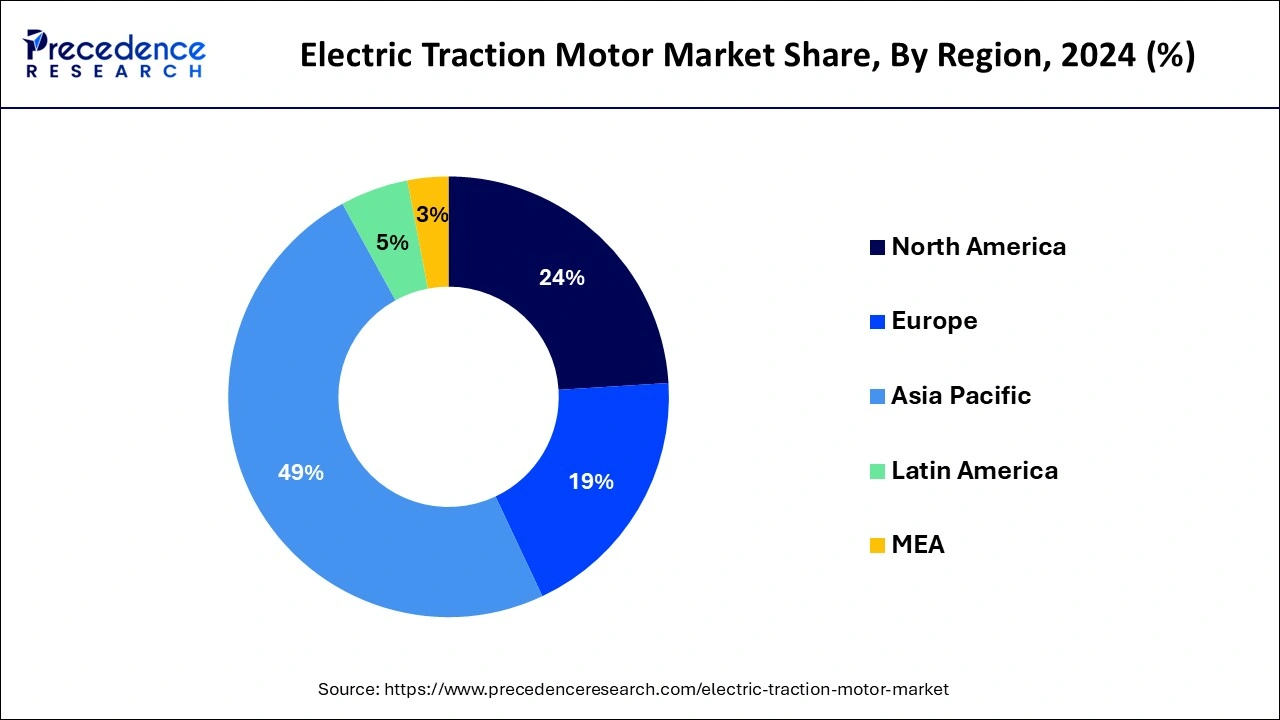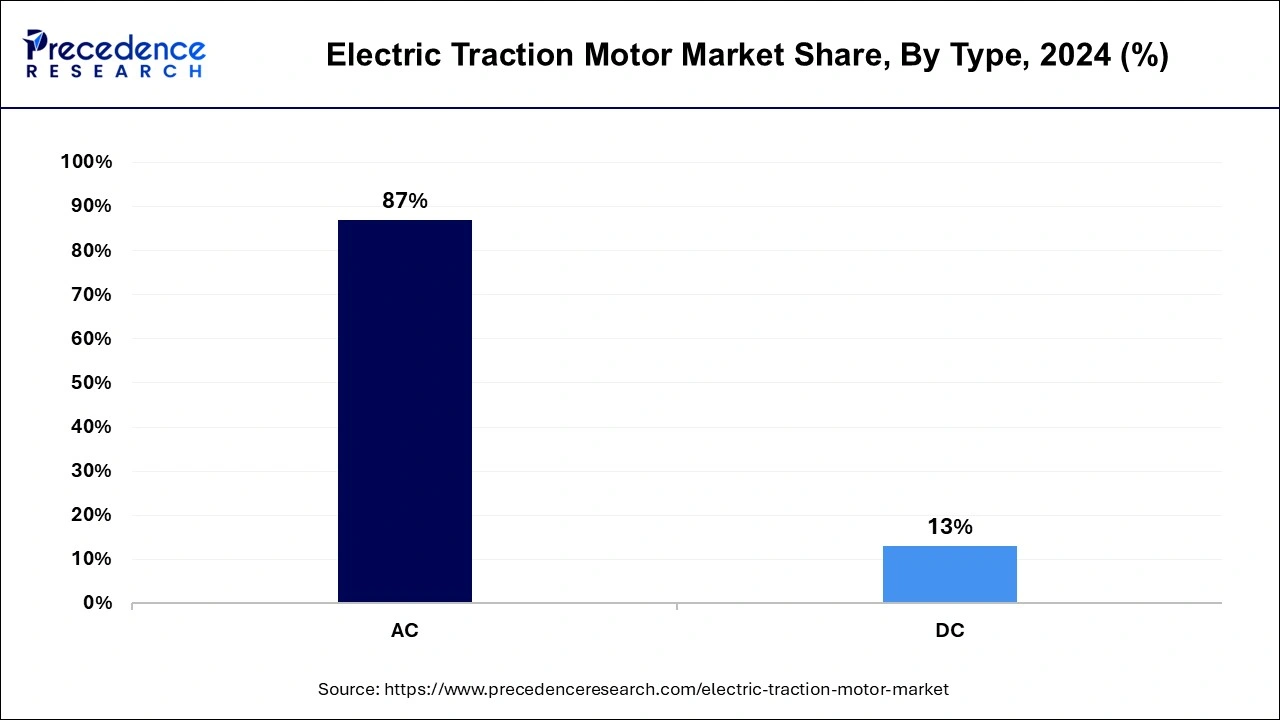January 2025
The global electric traction motor market size is estimated at USD 21.39 billion in 2025 and is predicted to reach around USD 86.24 billion by 2034, accelerating at a CAGR of 16.80% from 2025 to 2034. The Asia Pacific electric traction motor market size surpassed USD 10.48 billion in 2025 and is expanding at a CAGR of 16.92% during the forecast period. The market sizing and forecasts are revenue-based (USD Million/Billion), with 2024 as the base year.
The global electric traction motor market size was accounted for USD 18.25 billion in 2024, and is expected to reach around USD 86.24 billion by 2034, expanding at a CAGR of 16.80% from 2025 to 2034.

The Asia Pacific electric traction motor market size was estimated at USD 8.94 billion in 2024 and is predicted to be worth around USD 42.69 billion by 2034, at a CAGR of 16.92% from 2025 to 2034.

The market for EV traction motors in Asia Pacific became the biggest in 2024 and is predicted to develop at the quickest rate over the forecast period. Industry leaders in the area blame the growth of industrial facilities for this. Due to the cheap access to labour and raw materials in China, the largest industrial facilities have been seen to start operating there. Over the past ten years, the Chinese government has invested more than $50 billion in the establishment of factories producing electric vehicles and their components. To increase the demand for EVs, the Chinese government has also decreased the number of conventional car licenses accessible. Over the projection period, North America is anticipated to experience a significant CAGR of over 35%. In terms of the sales of EV traction motors, it is likewise a significant region. The existence of reputable electric car manufacturers accounts for the region's greater proportion. However, in 2018, Europe had a market share of over 20%. Over the projected period, rising BEV demand is anticipated to fuel market expansion in the area.

The rising investments in electric vehicles and rising demand for energy-efficient motors are driving the market growth. Due to the low power consumption and great efficiency of EV traction motors, EV sales are on the rise. Furthermore, the demand for EVs is being driven by strict environmental laws and emission standards to protect environmental sustainability, generating ideal conditions for market growth.
Global sales of hybrid electric vehicles (HEVs) have surged as a result of a growing public preference for zero-emission automobiles. Consequently, it is anticipated that the market would benefit from the increased production of HEVs. Additionally, the government is launching a number of programmes to increase the sales of EVs, such as tax breaks and discounts, which is propelling the EV traction motor market.
Vehicles with traction motors are entirely hybrid and battery electric (BEVs). By offering almost zero emissions and exceptional fuel efficiency at ever-lower prices, BEVs and HEVs have been quickly gaining acceptance in the worldwide automotive industry. Globally, a large number of vehicle OEMs are currently developing innovative HEV and EV concepts. Additionally, avoiding electrical and magnetic losses is crucial if users are to receive the optimum range and fuel economy.
Additionally, structural, thermal, and electromagnetic concerns that are essential to vehicle performance, dependability, and cost must be taken into account by engineers during installation. Compared to conventional motors, traction motors for electric vehicles often operate more quietly and accelerate more quickly. Additionally, unlike conventional cars, electric vehicles traction does not require a multi-speed transmission since, in contrast to reciprocating engines, electric motors have a more advantageous torque-speed connection that allows them to deliver the most torque even at the lowest speed. Additionally, scientific developments in fields like nanotechnology and material science are concentrated on lowering cost and weight while extending the lifespan and functionality of traction motors, making EVs more accessible.
The global market for electric traction motors is being driven by increasing investments in the railway industry, a high demand for powerful motors for propulsion applications, and a growing focus on electric cars to reduce carbon emissions. Due to rising investments in railway projects, particularly those involving high-speed rail and metro trains, nations like India, Australia, and South Korea are also seeing positive growth in the electric traction motor market. Additionally, it is anticipated that price fluctuations for raw materials like copper and aluminium would restrain the market's expansion for electric traction motors.
| Report Coverage | Details |
| Market Size in 2025 | USD 21.39 Billion |
| Market Size by 2034 | USD 86.24 Billion |
| Growth Rate from 2025 to 2034 | CAGR of 16.80% |
| Base Year | 2024 |
| Forecast Period | 2025 to 2034 |
| Segments Covered | Vehicle Type, Type, Power Rating, and Application |
| Regions Covered | North America, Europe, Asia-Pacific, Latin America, and Middle East & Africa |
Motor failure is a major limitation: A machine's or technology's motor is a crucial component. The traction motor's difficulties have a significant negative impact on demand as a whole. To address this problem, the major market participants are increasing their R&D spending. The market demand and market development, however, will be greatly impacted by engine overheating and failure.
The complex process for manufacturing of electric traction motors: High-end raw constituents are required to produce this energy-efficient technology. In the process, premium metals like copper and aluminium are employed. The electric traction motor, however, has difficulties due to the fluctuating price of raw materials. Several market irregularities are brought on by the low or high price fluctuations of raw materials. The reliability as well as safety of the operation of an electric traction motor can be impacted by selecting low-cost raw material substitutes. The cost of raw materials is a significant obstacle for the market's top competitors.
A battery-powered vehicle is one that runs entirely on chemical energy from rechargeable battery packs. Instead of using traditional IC engines for propulsion, battery electric vehicles employ motor controllers and electric motors. Due to a significant shift in consumer attitude toward zero emission vehicles, the BEV category is anticipated to dominate the market for electric vehicle traction motors throughout the forecast period. The BEV market is anticipated to rise as a result of technological developments including long-range batteries with quick charging capabilities. To enable EVs to go up to 200 miles on a single charge, the market is heading toward battery capacities of 60kWh. The higher battery capacity is anticipated to positively affect the market for electric vehicle traction motors by cascading the demand for battery electric vehicles. Greater government involvement also has a significant impact on encouraging people to purchase BEVs.
During the anticipated period, the AC segment is anticipated to be the market's biggest by type for electric traction motors. The benefits of AC motors include ease of manufacture as they don't require any mechanical parts to work, as well as being lighter than DC motors for the same power. Utilizing cutting-edge electronics enables the AC units to work meticulously and effectively to increase traction and adhesion.

It can be precisely monitored by microprocessors, which also aids in redeveloping current till it stops. At low speeds, DC regeneration falls rapidly. In the current industrial area, these items are most frequently employed in a variety of applications, including electric cars, conveyors, and industrial gear. In the automotive industry, AC motors are used more frequently. These are the elements that are anticipated to boost demand for AC motors.
By Vehicle Type
By Type
By Power Rating
By Application
By Geography
For inquiries regarding discounts, bulk purchases, or customization requests, please contact us at sales@precedenceresearch.com
No cookie-cutter, only authentic analysis – take the 1st step to become a Precedence Research client
January 2025
January 2025
January 2025
September 2024